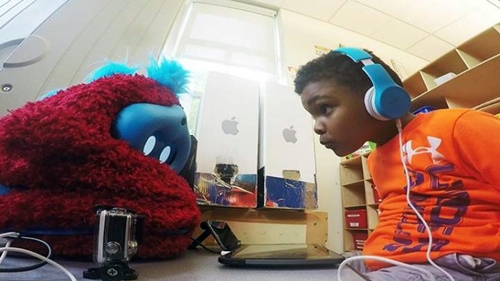4 December 2015. National Institutes of Health is funding research and development of new robotic devices to help older people or those with disabilities and serve as companions for children. Agencies in NIH plan to spend $2.2 million on these cooperative robotic, or co-robot, devices over the next five years, as part of the National Robotics Initiative that encompasses National Science Foundation, DARPA, NASA, and Department of Energy, as well as NIH.
One project is a smart walker to help older people carry out day-to-day tasks. This device, being developed in the Human-Centered Bio-Robotics lab of engineering professor Xiangrong Shen at University of Alabama in Tuscaloosa, aims to provide more mobility for older people, which can help them stay in their homes without expensive modifications such as ramps or wheelchair lifts. The smart walker is a four-legged system that provides varying amounts of balance and weight-bearing support for users. It has a separate “mule” mode with computer vision that walks alongside an individual to carry heavy loads, such as packages or groceries.
At University of Arkansas in Little Rock, engineering professor Cang Ye is building an assistive device worn like a glove over the hand to help visually-impaired people better find and grasp objects. The glove will have a small camera that uses computer vision to quickly find objects like door handles, as well as identify and manipulate movable obstacles. Cang Ye’s Intelligent Autonomous Systems Lab previously developed a smart white cane with a camera to help blind people better navigate their homes and streets.
Cynthia Breazeal at Massachusetts Institute of Technology is developing a co-robot device that serves as a social companion for young children. Breazeal’s Personal Robots Group in MIT’s Media Lab studies human-robot interactions and designs systems that impart social and intellectual benefits. This new device aims to assess and promote curiosity in preschool-age children through various interactions, as it operates as an autonomous long-term companion for kids. The project includes an evaluation of the system as it interacts with children over six months.
Grace Peng, program director at National Institute of Biomedical Imaging and Bioengineering, and NIH’s coordinator for National Robotics Initiative says in an agency statement that “robots have a tremendous potential to contribute to the health and well-being of our society, whether they are helping an elderly person engage in physical activity or promoting the curiosity of a child. Peng adds that the projects, “demonstrate the power of encouraging leaders in the field of robotics to focus their attention on solving issues that pertain to health.”
Read more:
- Wearable Personal Instruction System Being Developed
- Robotic Exoskeleton Developed for Upper-Body Rehab
- Robot for Reaching Children With Autism Demonstrated
- Robotics Designed for Laundry and Other Uncertain Tasks
- Mind-Controlled Prosthetic Arm Given Long-Term Test
* * *


 RSS - Posts
RSS - Posts
[…] NIH Funding New Robotics for Disabled, Children […]